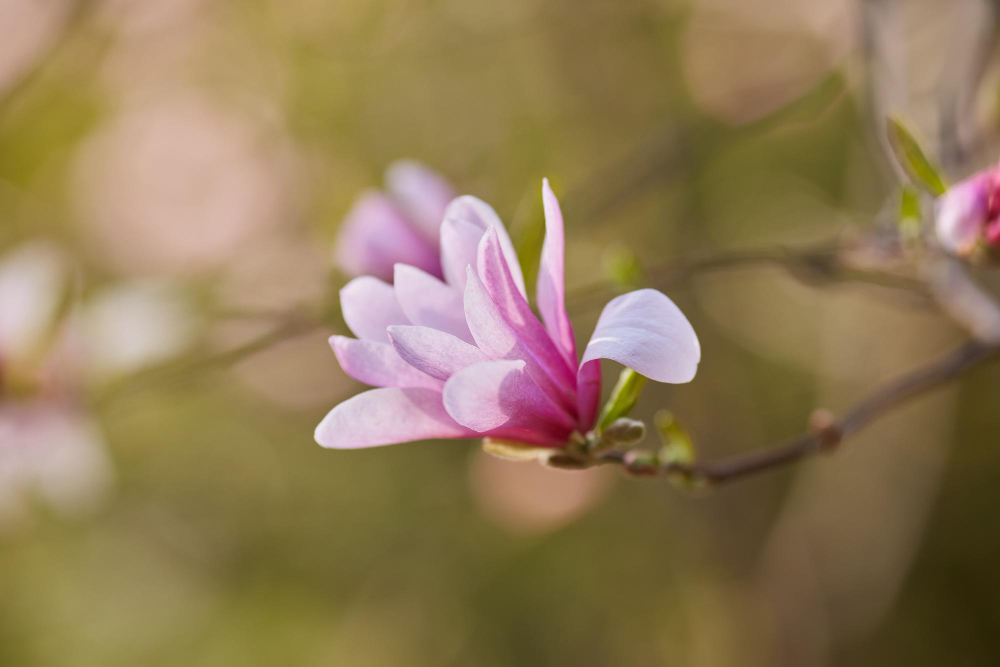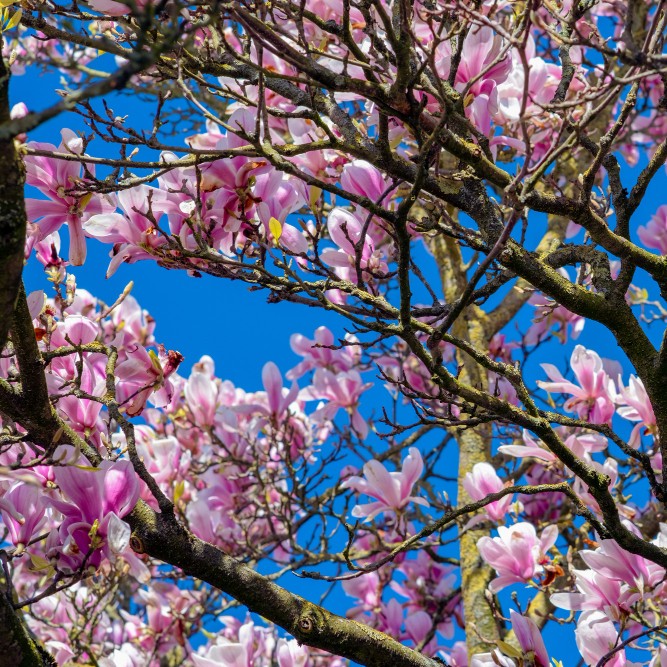Magnolias are the Royalty of the spring garden. With their magnificent, often fragrant blooms appearing on bare branches or nestled amongst glossy leaves, they offer a breathtaking spectacle. While they might seem imposing, many magnolias are surprisingly straightforward to grow if you give them the right start. This guide provides the essentials for successfully planting and caring for these stunning trees and shrubs in your British garden.
Why choose a Magnolia?
- Spectacular flowers: From pure white through pinks, purples, creams, and even yellows, the goblet or star-shaped flowers are simply stunning.
- Early colour: Many deciduous varieties bloom in early to mid-spring, providing colour when little else is flowering.
- Structure and form: Even out of flower, magnolias often have an elegant shape and attractive bark or foliage (especially evergreen types).
- Variety: There’s a magnolia for almost any garden size, from compact shrubs like Magnolia stellata to large specimen trees like Magnolia campbellii.

Choosing the right Magnolia
Before you buy, consider:
- Size: This is crucial! Check the ultimate height and spread on the plant label. Choose a variety that will comfortably fit your space without needing excessive pruning later. Smaller gardens might suit Magnolia stellata (Star Magnolia) or smaller Magnolia x soulangeana cultivars.
- Type:
- Deciduous: Lose their leaves in winter, usually flower spectacularly on bare branches in spring (e.g., M. stellata, M. x soulangeana, M. liliiflora).
- Evergreen: Keep their leaves year-round, often flowering in summer (e.g., Magnolia grandiflora). These tend to need more sheltered spots, especially further north.
- Flowering time: Early-flowering varieties can sometimes have their blooms damaged by late frosts. Consider a later-flowering type if you live in a frost-prone area.
When and where to plant
When:
- Autumn (October-November): Ideal, as the soil is still warm, allowing roots to establish before winter.
- Spring (March-April): Also a good time, once the worst of the winter cold and wet has passed, but before the summer heat arrives.
- Avoid planting in waterlogged winter soil or during summer drought.
Where:
- Sunlight: Most magnolias thrive in full sun or light, dappled shade. More sun generally means more flowers.
- Shelter: Essential! Protect from strong winds, which can damage large flowers and branches. Early-flowering types particularly need shelter from cold easterly winds and frost pockets to protect the blooms. A spot near a wall or fence can be ideal.
- Soil: Magnolias prefer fertile, moist, but well-drained soil. They generally favour neutral to slightly acidic conditions. If your soil is heavy clay or very sandy, improve it generously with well-rotted organic matter (compost, leaf mould, or well-rotted manure) before planting. Avoid sites that become waterlogged. While some tolerate slightly alkaline soil (like M. stellata), many perform poorly on shallow chalky soils.
How to plant your new Magnolia
Follow these steps for planting container-grown magnolias:
- Hydrate: Water the plant thoroughly in its pot before you start.
- Dig the hole: Dig a hole that is roughly the same depth as the root ball but at least twice, preferably three times, as wide. Loosen the soil on the sides and base of the hole with a fork.
- Improve the soil: Mix some well-rotted organic matter with the soil you removed from the hole. Avoid adding fertiliser directly into the planting hole.
- Position the plant: Gently remove the magnolia from its pot, teasing out any circling roots if necessary. Place the plant in the centre of the hole. Crucially, ensure the top of the root ball is level with the surrounding soil surface. Planting too deep is a common mistake and can harm the plant.
- Backfill: Refill the hole with the improved soil mixture, gently firming it around the root ball with your hands or feet to eliminate large air pockets. Avoid compacting the soil too heavily.
- Water thoroughly: Water the newly planted magnolia generously to settle the soil around the roots.
- Mulch: Apply a layer of organic mulch (such as bark chippings, garden compost, or leaf mould) around the base of the plant, about 5-8cm (2-3 inches) deep. Keep the mulch clear of the main stem to prevent rotting. Mulching helps retain moisture, suppress weeds, and keep the roots cool.

Caring for your Magnolia
Magnolias are relatively low-maintenance once established.
- Watering: Water regularly during the first couple of growing seasons, especially during dry spells. Ensure the water penetrates down to the roots. Mature trees are more drought-tolerant but will appreciate watering during prolonged hot, dry periods.
- Feeding: Magnolias generally don’t need heavy feeding. An annual application of a balanced granular fertiliser (like Growmore or fish, blood, and bone) in spring can be beneficial, scattered over the root area and lightly worked in. Alternatively, simply replenishing the organic mulch each spring often provides sufficient nutrients. If your soil is borderline alkaline, an ericaceous fertiliser might help some varieties.
- Mulching: Replenish the mulch layer each spring. This is one of the best things you can do for your magnolia.
- Pruning: Minimal pruning is best. Magnolias generally develop a naturally elegant shape and flower best on unpruned growth.
- Only remove dead, damaged, diseased, or awkwardly crossing branches.
- If essential shaping is required, prune deciduous types immediately after flowering in spring/early summer.
- Prune evergreen types in late spring.
- Avoid heavy pruning, as it can spoil the shape and reduce flowering. Magnolias heal slowly from large cuts.
Tips for beginners:
- Choose wisely: Select a variety suited to your garden’s size and conditions.
- Site selection is key: Sun, shelter, and well-drained soil are paramount.
- Don’t plant too deep: Ensure the top of the root ball is level with the soil surface.
- Water well initially: Keep young plants consistently moist, especially in dry weather.
- Mulch annually: This helps retain moisture and feeds the soil.
- Prune sparingly: Only remove dead or damaged wood, or prune lightly for shape immediately after flowering (deciduous) or in late spring (evergreen).
- Be patient: Magnolias may take a few years to flower profusely, but they are well worth the wait!
Growing a magnolia is a rewarding experience. With the right selection and care, these magnificent plants will bring elegance and spectacular beauty to your garden for many years to come. Come see our beautiful magnolia trees in our outside plant area.




